MARIANI’S
Virtual Gourmet
April 16,
2023
NEWSLETTER
ARCHIVE

UKRAINIAN EASTER EGGS
❖❖❖
THIS WEEK
PALAZZO DUCALE VENTURI
By John Mariani
NEW YORK CORNER
LUTHUN
By John Mariani
GOING AFTER HARRY LIME
CHAPTER SIXTEEN
By John Mariani
NOTES FROM THE WINE CELLAR
ARE WINE TASTINGS COUNTER TO COMMON SENSE?
By John Mariani
 Morante,
Baseball Historian about YANKEE
STADIUM. Go to: WVOX.com.
The episode will also be archived at: almostgolden.
Morante,
Baseball Historian about YANKEE
STADIUM. Go to: WVOX.com.
The episode will also be archived at: almostgolden.
PALAZZO DUCALE VENTURI
Minervino di Lecce
+39-0836-818717
By John Mariani
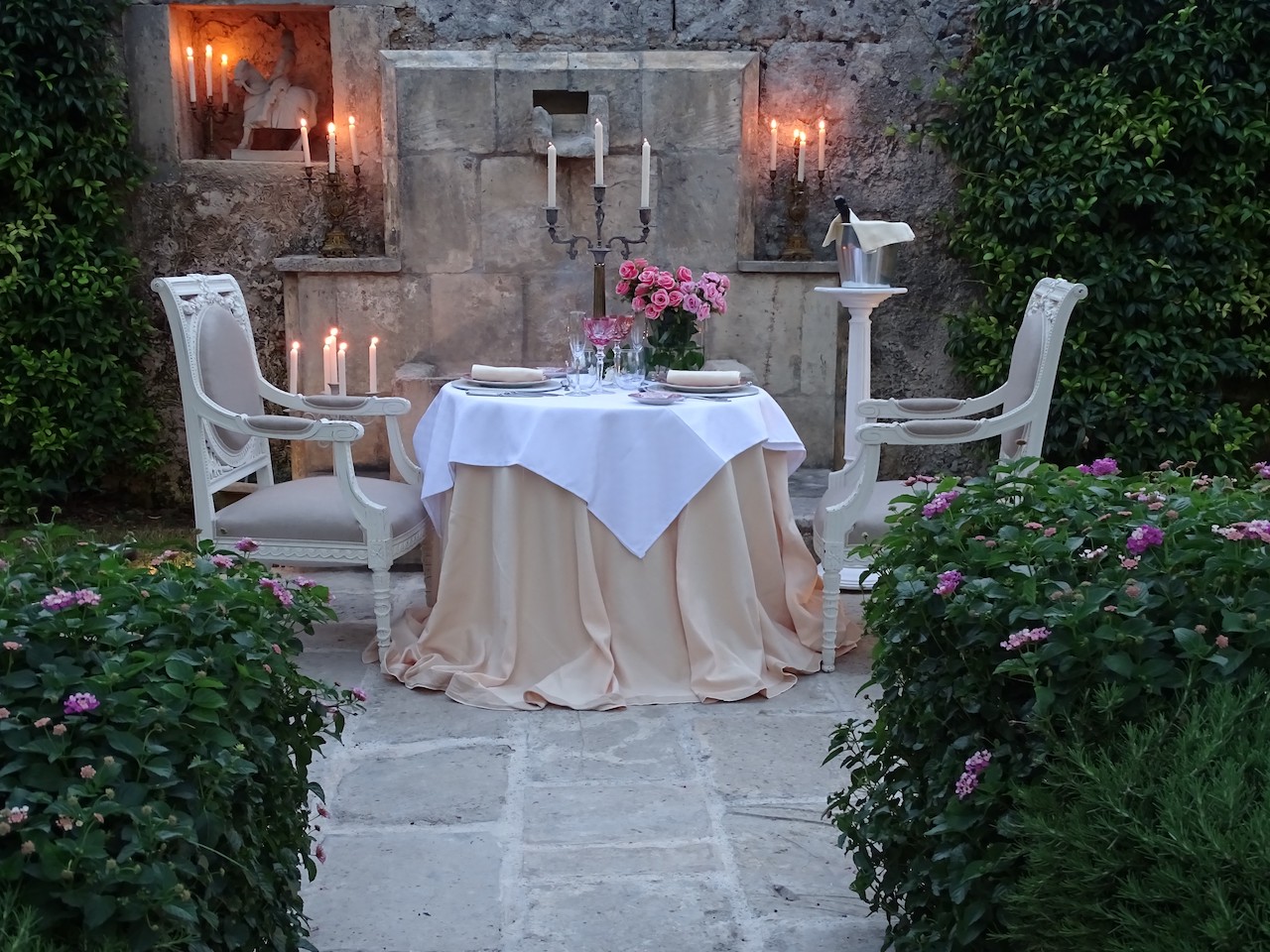
Counting the angels on the head of
a pin would be child’s play compared to
estimating all of the antique palazzos
throughout Italy. Even the poorest district
seems once to have a rich man on the
hillside who was able to cobble together the
resources (and taxes) to create a fairly
safe and secure stone mansion, while the
richest brandished their wealth and power in
astonishments like the Villa d’Este in
Tivoli and the Palazzo Reale in Naples.
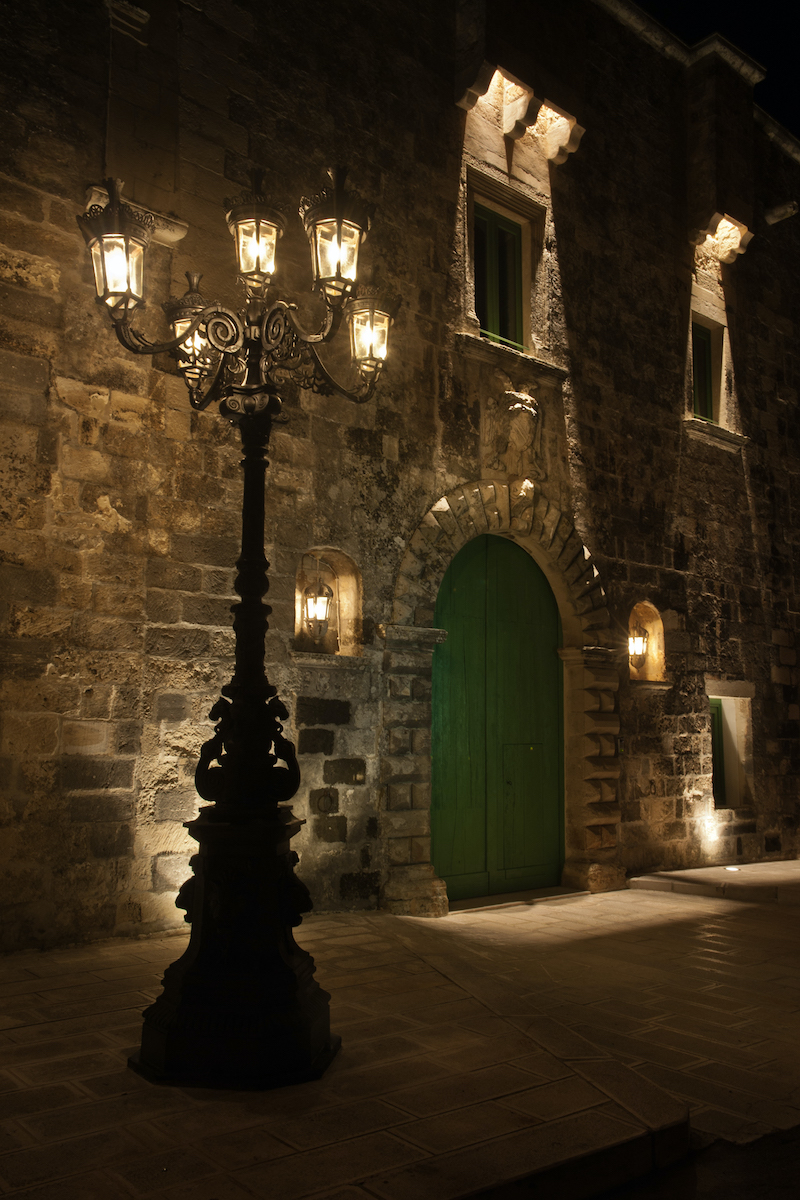 Far
from the big cities, many
palazzos were often summer residences that
became the focal point for the town’s
identity. Centuries of being taken over by
invaders, disastrous economic downturns and
social upheavals—not least two World Wars in
the last century—forced the abandonment of
many that thereupon went to wrack and ruin.
One of these is the Palazzo Ducale Venturi in
the small Puglian town of Minervino di Lecce.
Though isolated, the town is only 25 miles
from Lecce and 15 minutes from Otranto.
Far
from the big cities, many
palazzos were often summer residences that
became the focal point for the town’s
identity. Centuries of being taken over by
invaders, disastrous economic downturns and
social upheavals—not least two World Wars in
the last century—forced the abandonment of
many that thereupon went to wrack and ruin.
One of these is the Palazzo Ducale Venturi in
the small Puglian town of Minervino di Lecce.
Though isolated, the town is only 25 miles
from Lecce and 15 minutes from Otranto.
There’s little to see in the town
beyond the various churches (some shuttered),
and the façade of the Palazzo, built in 1500
as a Templar stronghold, is not
promising, looking somewhat like the Alamo
after the Mexican Army stormed it. But once
through a creaking, old green wooden door, an
entirely different world of Italian luxury
expands from a foyer to a grand living room to
a garden and pool and a modern spa called the
Wellness Area.
I doubt the Duke Venturi lived in
anything close to the comfort guests can now
enjoy, with 20 rooms and suites, some of which
have ancient murals on vaulted ceilings. The
local limestone was restored to a pale golden
glow, and the fireplaces re-lighted, including
a wood-fired pizza oven and a cozy whiskey bar
where you may take a course in spirits,
followed by dinner.
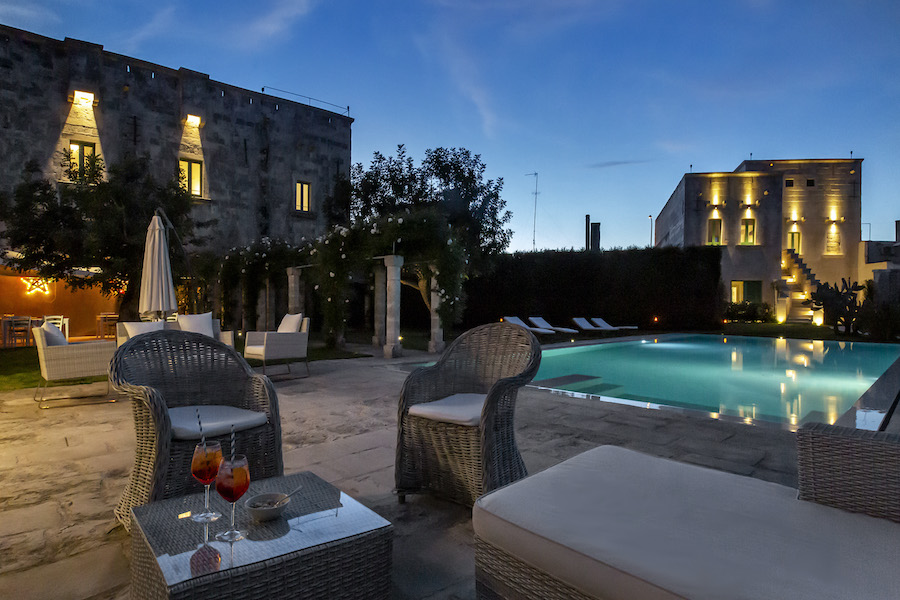 There is a bittersweet
legend that involves the Palazzo, which once
had a secret underground passageway to the
nearby Monastery where the Duke would liaison
with the Abbess. But, alas, after
a few years, he tired of her and took up with
a young novice nun whom the Abbess, in a fit
of jealous rage, had murdered and buried in an
There is a bittersweet
legend that involves the Palazzo, which once
had a secret underground passageway to the
nearby Monastery where the Duke would liaison
with the Abbess. But, alas, after
a few years, he tired of her and took up with
a young novice nun whom the Abbess, in a fit
of jealous rage, had murdered and buried in an
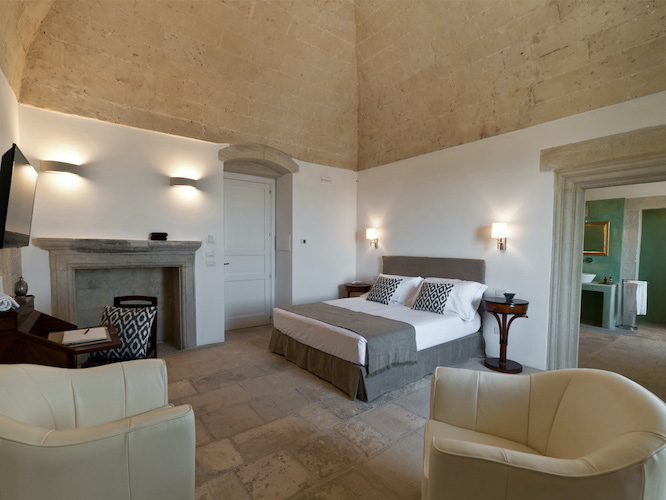 underground vault,
putting a curse on the duke’s bedroom—Hic
amor mori: “Here love died”—which was
fortunately lifted by Saint Eligio later in
the 16th century. The once
walled-up room is, romantically, again
available to stay in.
underground vault,
putting a curse on the duke’s bedroom—Hic
amor mori: “Here love died”—which was
fortunately lifted by Saint Eligio later in
the 16th century. The once
walled-up room is, romantically, again
available to stay in.
When my wife and I stayed at the
Palazzo last autumn, we were struck by the
cool quiet of the hotel, which extends to the
Wellness Area with its serene spa, the
beautiful garden with its entwined arbors and
the remarkably large, underlighted pool area.
It is all as enchanting at night as it is
during the day, and moonlight works its
wonderful ministry on the walls and water.
Rooms are capacious, with arched
limestone ceilings and painted walls, the
furniture is tones of gray and taupe.
Bathrooms are large and very modern, the WiFi
connection is exemplary (though I found that
T-Mobile has no coverage in the region, a lack
easily fixed by buying a SIM card for a few
bucks). The
furnishings of the public rooms, which are
painted off-white and reflect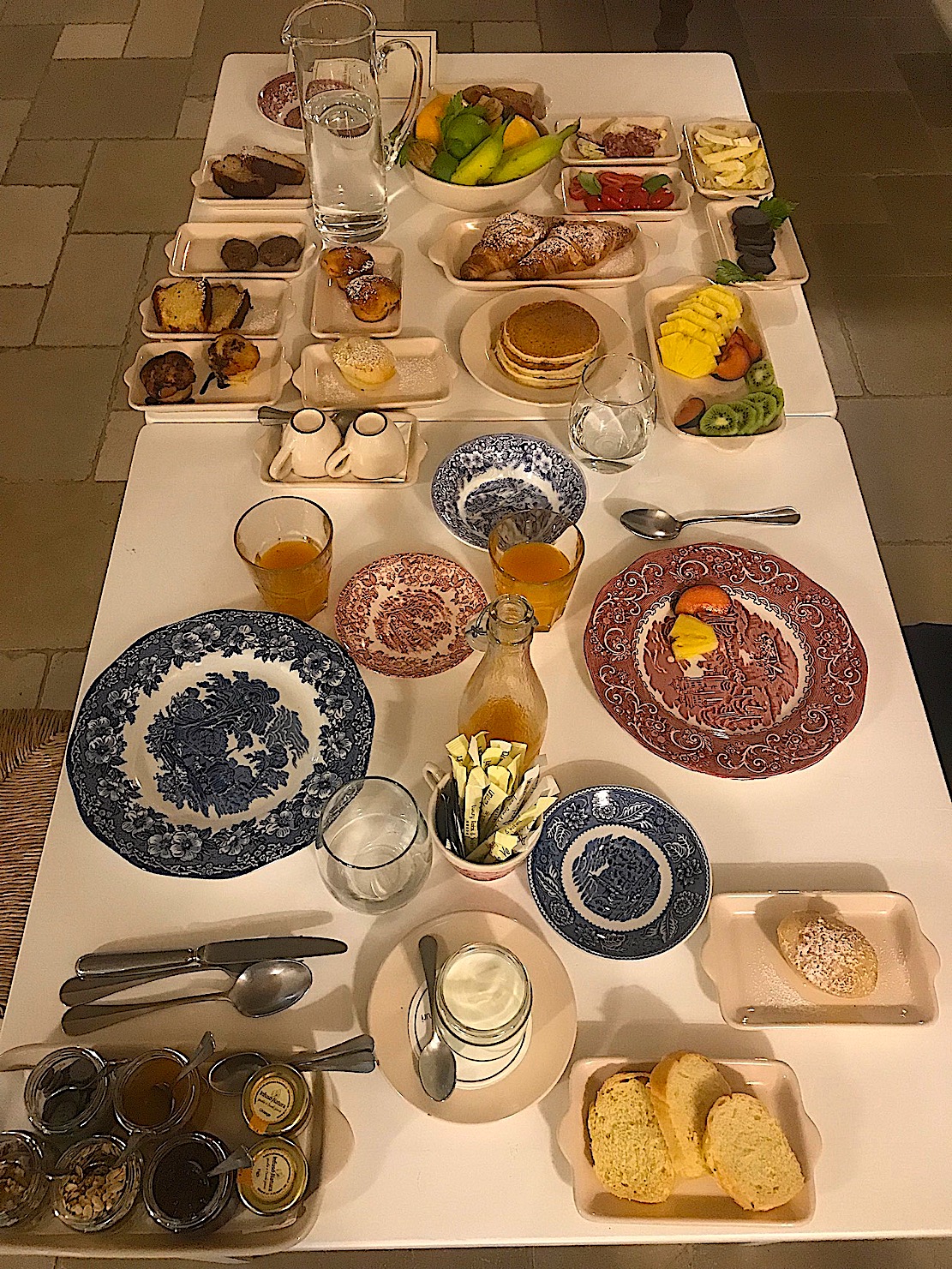 a great deal of light from floor-to-ceiling
windows, are judiciously set with
first-quality antiques rather than crammed
with artwork of questionable provenance. A
motif of soothing, muted green is used
throughout on the woodwork.
a great deal of light from floor-to-ceiling
windows, are judiciously set with
first-quality antiques rather than crammed
with artwork of questionable provenance. A
motif of soothing, muted green is used
throughout on the woodwork.
The intimate dining room with ceiling
mural, appended with outdoor tables that allow
you dine in the garden or by the pool, is
where we had our extensive breakfasts
(included in the room price), which ranged
from breads and pastries to pancakes and
cheeses, fruits and juices all served at a
long, well-set table
with local china. You can also learn to make
pizza here, and Chef Antonio Russo holds
cooking classes, including one for pasta that
would be incorporated
into
our meals.
At one of our dinners, sitting at a
communal table with other guests, we began
with little strips of breaded ombrina
fish.
The pasta course was pacchero
macaroni with a rich seafood ragù atop
pureed yellow tomato scented with 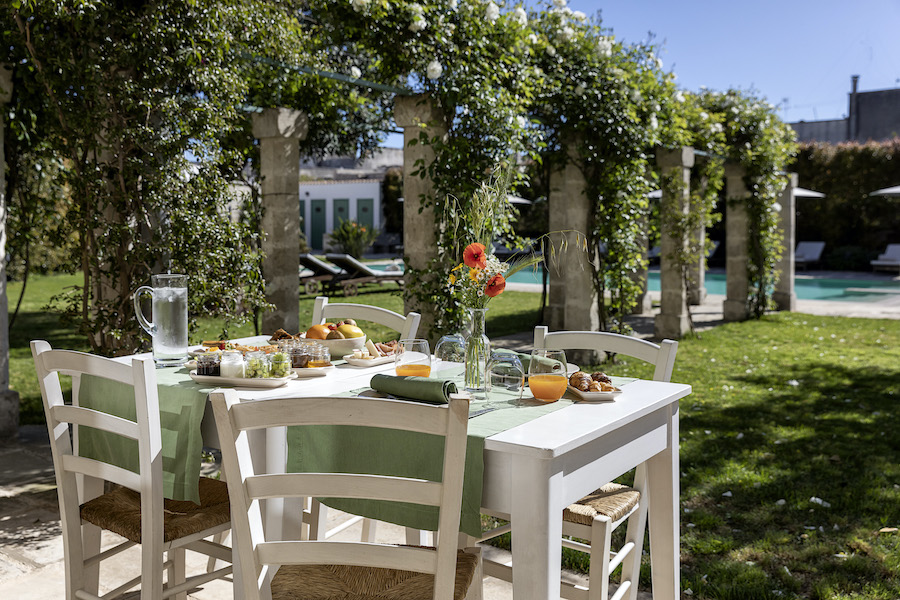 marjoram and dressed
with red lumpfish roe. Then came stuffed
tender squid on a sauce of red cabbage, and
for dessert local pastries, served
with wines from a modestly priced wine list
rich in Puglian bottlings: Piccole Bolle
Bianco Negroamaro from Duca Carlo Guarini and
Fiano Salento from Cantina Schola Sarmenti.
marjoram and dressed
with red lumpfish roe. Then came stuffed
tender squid on a sauce of red cabbage, and
for dessert local pastries, served
with wines from a modestly priced wine list
rich in Puglian bottlings: Piccole Bolle
Bianco Negroamaro from Duca Carlo Guarini and
Fiano Salento from Cantina Schola Sarmenti.
As you’d expect, Americans form a large part
of the Palazzo’s clientele, so every
employee speaks impeccable English, not
least Angela Venturi, owner and CEO of the
tour company DMC Path and manager Martina
Provenzano, who are never happier than when
you ask them to show you their region.
Owing to its
proximity to towns, cities, seashore and
historic sites, the Palazzo also has the
virtue of being secluded, making it as much a
romantic getaway as it is an example of modern
Italian hospitality.
❖❖❖
NEW YORK CORNER
LUTHUN
432
East 13th Street
646-454-9484
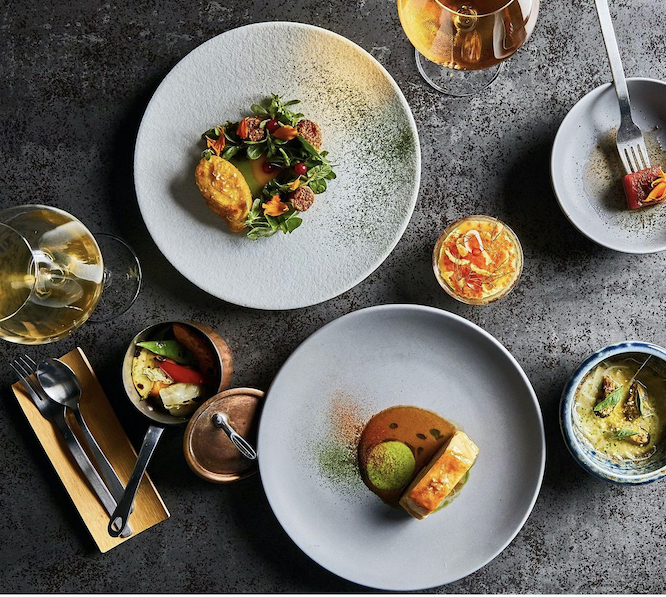
By John Mariani
Photos
by Michael Tulipan and Luthun
%20and%20Chef%20Partner%20Arjuna%20Bull%20(r)%20by%20Honest%20Media.jpg) By
the same token, I have very much enjoyed
somewhat more abbreviated (in both number of
courses and time spent) at admirable
multi-course restaurants like Jung Sik ($155),
Wicked Jane ($95), Frevo ($198) and, most
recently, Luthun ($150) on Manhattan’s Lower
East Side. In each of these, the dedication of
the chef within a small kitchen is more clearly
to delight rather than dazzle the guests, who
are fewer in number than at those others.
By
the same token, I have very much enjoyed
somewhat more abbreviated (in both number of
courses and time spent) at admirable
multi-course restaurants like Jung Sik ($155),
Wicked Jane ($95), Frevo ($198) and, most
recently, Luthun ($150) on Manhattan’s Lower
East Side. In each of these, the dedication of
the chef within a small kitchen is more clearly
to delight rather than dazzle the guests, who
are fewer in number than at those others.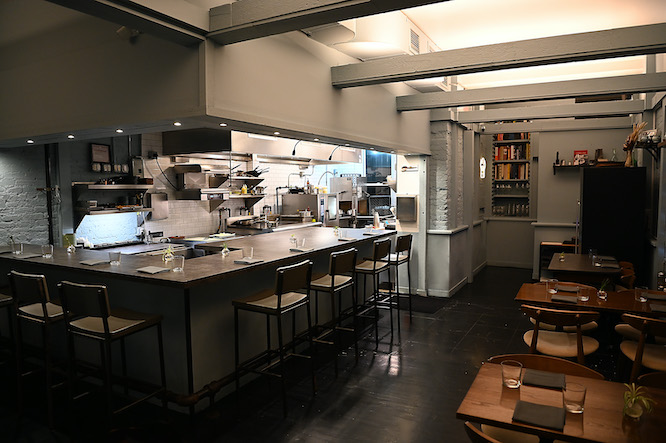 El Bulli in
Spain, The Fat Duck outside London and Restaurant
Philippe Rochat in Lausanne. In New York he was
executive chef at Respite.
El Bulli in
Spain, The Fat Duck outside London and Restaurant
Philippe Rochat in Lausanne. In New York he was
executive chef at Respite. Sommelier Jahdea Gildin has compiled a very varied wine list, and with this kind of food, where matching flavors and wine is impossible before you taste a dish, it’s best to allow him to choose the beverages, which may range from a vermouth to sake to beer to wine.
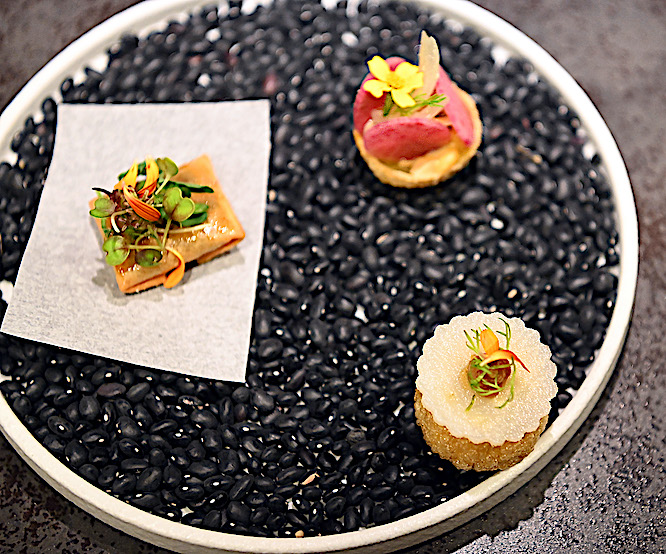 The premises
are fairly stark, but good lighting, a counter
directly in front of the kitchen, unobtrusive
music and exceptionally cordial servers make
Luthun a very comfortable place to dine and
interact with the full staff and perhaps with
the people seated next to you. Each dish is
described at a reasonable length—although the
word “awesome” is used way too much—and Ahmed
and Bull are right there ready to chat, having
gotten the tempo of the meal down pat. No one in
the kitchen seems rushed. No one gets yelled at.
The premises
are fairly stark, but good lighting, a counter
directly in front of the kitchen, unobtrusive
music and exceptionally cordial servers make
Luthun a very comfortable place to dine and
interact with the full staff and perhaps with
the people seated next to you. Each dish is
described at a reasonable length—although the
word “awesome” is used way too much—and Ahmed
and Bull are right there ready to chat, having
gotten the tempo of the meal down pat. No one in
the kitchen seems rushed. No one gets yelled at.
Our ten-course meal began with a fushka (above)—Bangladesh street food—little pastry cups of sugar snap
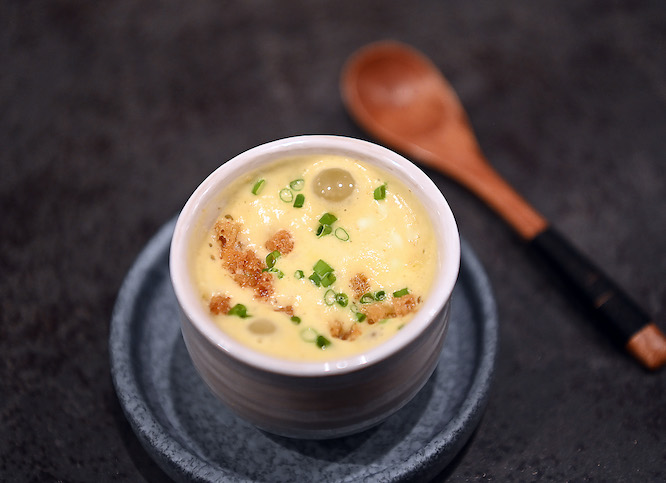 peas
with pine nuts and calamansi lemon. “Halal Guys”
samosas take their name from a New York chain of
halal food carts from
Ahmed’s childhood, served with tangy-sweet
pineapple chutney. A plump caramelized
mussel was dressed with passion fruit and a
pinch of wasabi, while a pretty scallop was
perched on salted onion blossom and mandarin kosho,
a chile and Mandarin mixture.
peas
with pine nuts and calamansi lemon. “Halal Guys”
samosas take their name from a New York chain of
halal food carts from
Ahmed’s childhood, served with tangy-sweet
pineapple chutney. A plump caramelized
mussel was dressed with passion fruit and a
pinch of wasabi, while a pretty scallop was
perched on salted onion blossom and mandarin kosho,
a chile and Mandarin mixture.Lovely, translucent, raw, lightly brined fluke took on flavors from fermented cashew, amloki, Indian gooseberry, and shiso. Mild uni was made into a custard with trout roe and farro to add texture (right). All these dishes were decorated via tweezers used to apply tiny edible greens or flowers.
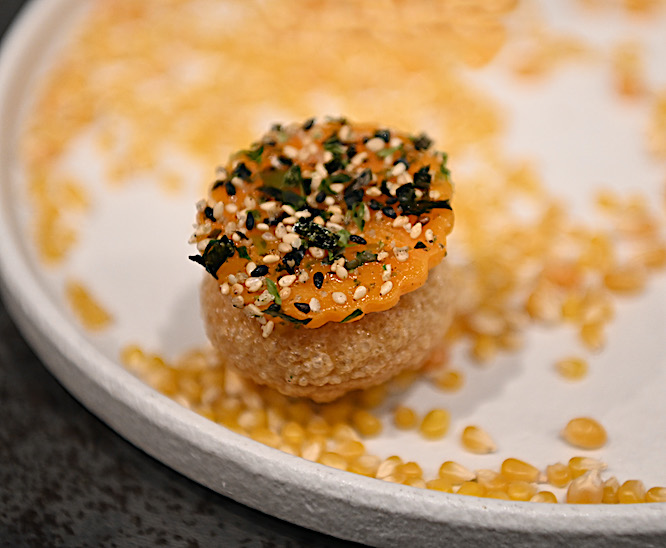 The simplest
dish was beef tartare dashed with whiskey
vinegar placed
on an egg yolk cooked with seaweed and bonito,
topped with Chinese caviar and grated cured egg.
This was followed by
lightly smoked squid in an oxtail consommé
tinged with XO black truffle vinegar. The Indian
bread called roti had
a sweetness to it with a yuzu
and pistachio salsa. In fact, there is a touch
of sweetness in many of the dishes, something
that should be done sparingly lest it become
cloying.
The simplest
dish was beef tartare dashed with whiskey
vinegar placed
on an egg yolk cooked with seaweed and bonito,
topped with Chinese caviar and grated cured egg.
This was followed by
lightly smoked squid in an oxtail consommé
tinged with XO black truffle vinegar. The Indian
bread called roti had
a sweetness to it with a yuzu
and pistachio salsa. In fact, there is a touch
of sweetness in many of the dishes, something
that should be done sparingly lest it become
cloying.A foie gras emulsion with Thai nuoc cham fish sauce with cured egg
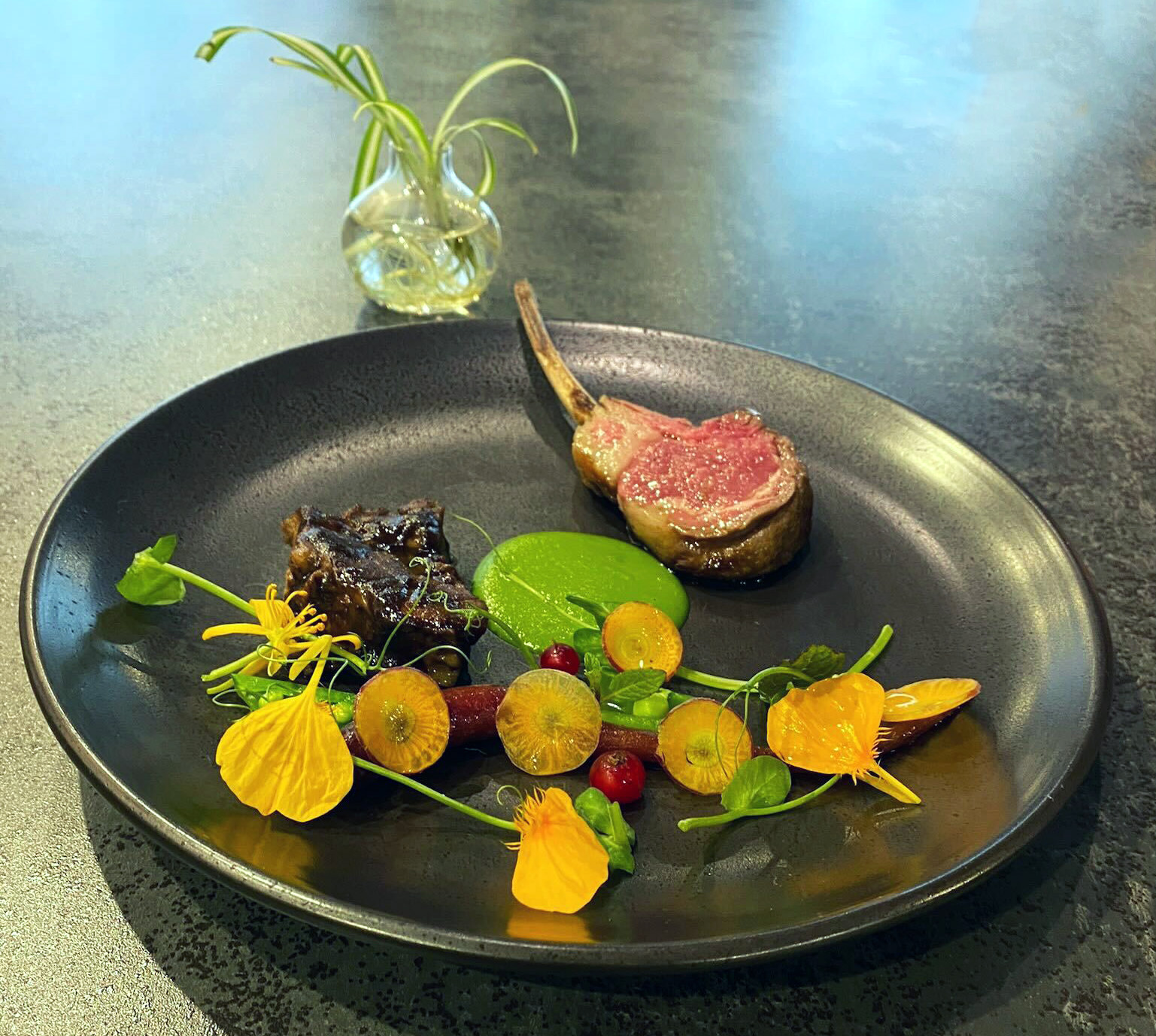 yolk
and
rice cake accompanied prawns, and the last
savory course was a rare, very juicy Colorado
lamb chop served two ways: a rare chop and
braised shoulder with the Turkish chile pepper urfa biber
and elderberry glaze and a mix of greens,
vegetables and flower (right).
yolk
and
rice cake accompanied prawns, and the last
savory course was a rare, very juicy Colorado
lamb chop served two ways: a rare chop and
braised shoulder with the Turkish chile pepper urfa biber
and elderberry glaze and a mix of greens,
vegetables and flower (right).Dessert was a pleasantly traditional chocolate mousse with a Champagne gelée Rose.
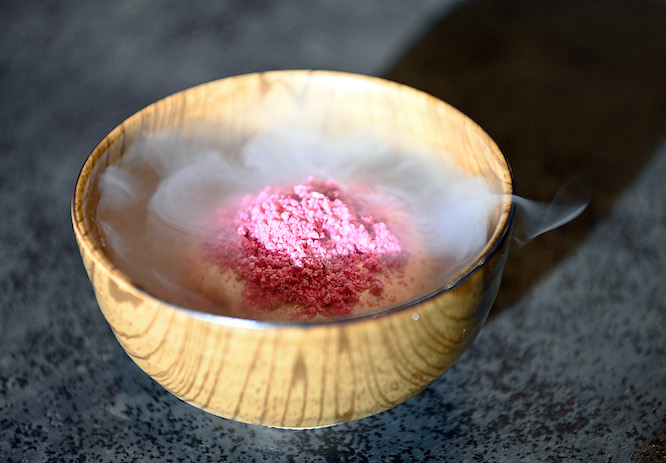 Our meal had a
fine cadence to it so, with each dish small in
size—bite-sized—there’s no long wait for the
next one. We spent something close to
two-and-a-half hours at the counter, and,
because of comfortable tall chairs and the small
number of guests to be served, we never felt
things dragged. Also, the amounts of beverages
served were judicious, given that so many
courses needed to be matched.
Our meal had a
fine cadence to it so, with each dish small in
size—bite-sized—there’s no long wait for the
next one. We spent something close to
two-and-a-half hours at the counter, and,
because of comfortable tall chairs and the small
number of guests to be served, we never felt
things dragged. Also, the amounts of beverages
served were judicious, given that so many
courses needed to be matched.Luthun is a special place and an antidote to those brash, bombastic, uncomfortable places where you may exit exhausted. Perhaps Luthun’s real distinction is that everyone manifests a civilized side of downtown dining, while others go for razzle dazzle rather than refinement. Having too often slogged through long meals delivered with the solemnity of a tithe collector, I enjoyed every minute of my time at Luthun.
Open
for dinner Wed.-Sat, with seatings at 5:30 and
8:30.
GOING AFTER HARRY LIME
By John Mariani

CHAPTER SIXTEEN

Holly Martins: “You used to
believe in God.”
Harry Lime: “Oh, I still do
believe in God, old man. I believe in
God and Mercy and all that. But the dead
are happier dead. They don't miss much
here, poor devils.” — The Third Man.
Katie and David looked at each
other in amazement.
“What do you mean he’s not dead?” asked
Katie. “He died eleven years ago in Moscow.”
Lentov was still smiling. “And who told you
that?”
David, bewildered and a little flushed,
stuttered, “Why, why all the, y’ know, newspapers
back then. All the obituaries.”
“Ah, yes,” said Lentov. “But did you ever
see a report in the Russian newspapers or media
about Philby dying?”
Katie and David said they didn’t know one
way or the other.
“If you look back at what happened,” said
Lentov, finishing the last of his pint, “you’ll
find that the western press heard—from supposedly
reliable sources—that Philby had passed away. They
didn’t know when or how or where, and it was days
before the Russians acknowledged the report was
true.”
“So, you’re saying the Russians are hiding
the fact he is still alive?” asked David.
“Well, they certainly never reported any
details on his purported death. And my own
sources—I still have a few—tell me that Kim is
still alive, not too well, still living in that
wretched flat in Moscow. I don’t doubt it for a
moment.”
“But why would the Russians lie about his
death?” asked Katie.
Lentov rose from the banquette, buttoned
his jacket and said, “I have to assume it was
easier to finally put the old man to rest, so to
speak, and not to have to explain what had
happened to him, where he was, etcetera. He had
been so long out of the spotlight, the Cold War
was over, he’d published his memoirs and MI6
certainly had no interest in bringing him back to
England and stirring up all the old embarrassments
to the service. Better forgotten for everyone
concerned. Philby probably agreed to the dodge. He
was probably deliriously happy about fooling
everyone one last time.”
The old Russian walked slowly to the door
of the pub, with Katie and David speechless behind
him. The sky had gone gray, threatening the kind
of cold drizzle that Lentov hated more than a good
soaking. The cold was nothing to a Russian but the
drizzle got into his bones.
Katie looked at David as if to say, what do
we do now? David spoke first. “Mr. Lentov, do you
think there  is
any possible way we could get to see Philby for an
interview?”
is
any possible way we could get to see Philby for an
interview?”
Lentov had expected the question, saying,
“It might have been easier right after the Soviet
Union collapsed. There was a sense of euphoria,
even if it was based on the false hopes of those
who didn’t know Russian history. Without a strong
man at the top, Russians have no history of nation
building. Yeltsin is a pig and a fool and a drunk. But in
those first days, there might have been an
opportunity for a journalist to enter Russia quite
freely and poke his nose around. Now, it
might not be so easy.”
“Why not?” asked Katie.
“The whole country is collapsing, so the
government needs to hide the deep corruption that
has allowed former bureaucrats and K.G.B.
operatives to become stinking rich. Philby may be
forgotten, but he will not be allowed an endgame. Getting
to him would be difficult.”
Lentov ran through recent Russian history,
saying there had been a great deal of power
shifting at the top. With his support foundering
and the economy in disarray, President Yeltsin
needed to consolidate his position, and after a
disastrous crop failure in 1998, he fired Prime
Minister Yevgeny Primakov (once head of Russian
intelligence) and installed Sergei Stepashin (also
a former head of the K.G.B.’s replacement, the
F.S.B.) as prime minister, then fired him two
months later.
In Stepashin’s place Yeltsin nominated an
up-and-coming politician named Vladimir Putin
(another former head of the F.S.B.), declaring
that one day Putin would succeed him as President
of Russia.
The name Putin rang a loud bell in Katie and
David’s heads, for during their Vermeer
investigations Putin had been suspected of having
been involved in the attempted assassination of a
Russian oligarch.
“I never knew Putin,” said Lentov. “After
my time. But my friends tell me he is extremely
devious and very dangerous. Let us take a walk to
the park before it rains.”
Southall Park was nearby. The three of them
walked slowly, Lentov continuing to talk. He
explained that when Russia opened up to the world
in 1991, the new regime had encouraged foreign
journalists to cover their achievements and to see
how free their country had become. Even the
Communist propaganda paper Pravda had broken into
two entities, one free of party control. Not for
the first time in its history, Russia turned West,
believing its culture shared more with Europe than
Asia.
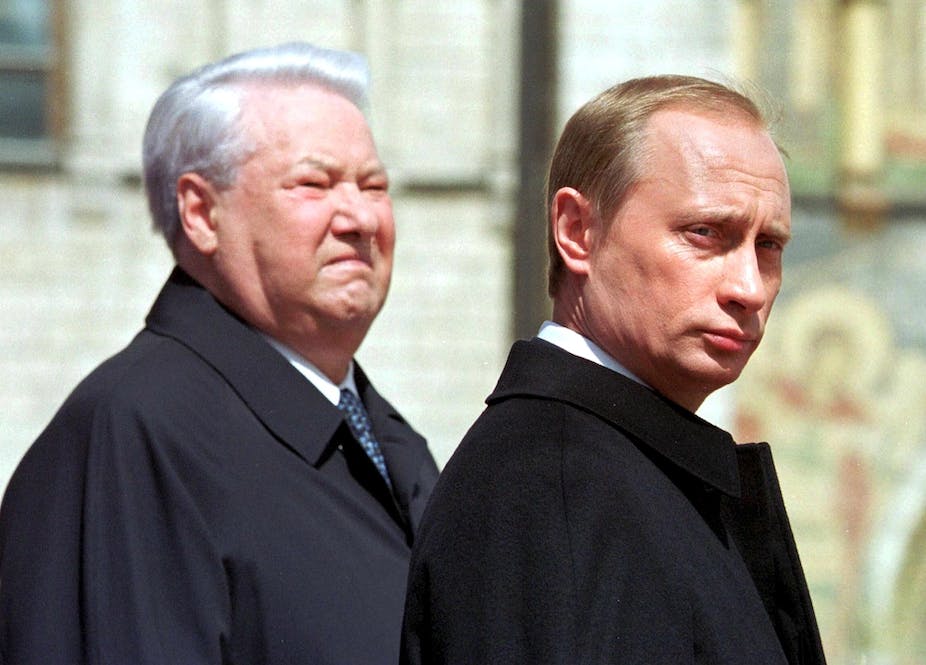 But before long the
goals of the new regime led by Yeltsin
disintegrated along with the economy and Russia’s
military, which was bankrupt and unable to keep up
with the advances in the West. Parity with the
United States was neither achievable nor even
advisable.
But before long the
goals of the new regime led by Yeltsin
disintegrated along with the economy and Russia’s
military, which was bankrupt and unable to keep up
with the advances in the West. Parity with the
United States was neither achievable nor even
advisable.
“The old oligarchs and the new
oligarchs are the same people,” said Lentov, “all
the old K.G.B. clan who knew where all the bodies
were buried and what was still in all the old
files. They used it all to become wealthy, more
and more from gas, oil and minerals, especially
Putin. He is that strong man Russians always
embrace to salvage a shred of dignity.”
Katie and David saw that Lentov had strayed
from the topic of Philby in favor of sounding
prophetic, as if his opinions still mattered to
anyone outside of Southall. David tried to get him
back on track, saying, “So, you don’t think there
is any way for us to get to Philby, now that the
regime has changed?”
Lentov tilted his head this way and that.
“Well, getting into Russia is not the
problem these days,” he said. “And, unless Philby
is living somewhere else, I do have his old
address.”
The openness of Lentov to tell Katie and
David such astonishing information—barely an hour
after they’d met—was more than puzzling. How could
this former Soviet agent, now living in disgrace,
simply blurt out a statement that contradicted
everything that had ever been written about the
Philby case? And now he was giving them the man’s
address?
David nodded to Katie, to say “You ask
him.”
Katie, not hiding her skepticism, asked,
“Mr. Lentov, why are you willing to tell us all
this? Are you saying you never shared this
information with MI6 or anyone in the British
government and that you, and you alone, knew that
Philby was still alive.”
Lentov put his arm around Katie’s shoulder,
but she drew away.
“I hear from my friend Southey that you are
both very good investigators,” said the Russian.
“And I’m well aware, David, you would never accept
anything I say at face value.”
David stood there stone-faced.
“Why should you?” Lentov continued. “Once a
liar always a liar, eh? It was my profession.
Obfuscation. Disinformation. Betraying
confidences. Surely you ran across men like me in
the Mafia. I won’t go into the moral differences
between the Mafia and intelligence agents, but
there is a point—you know this, David—when some
men become sick of the game and need to escape the
pit of lies they live in. It was not at all
difficult for me to go over to the British. My
career was ending, my life would be uneventful but
somewhat secure, even in Southall. As Moscow is to
Philby.”
Katie and David were
becoming impatient, hearing Lentov’s explanation
as little more than a defense of his treason.
“You haven’t answered my question,” said
Katie. “If you felt you needed some kind of . . .
redemption, why didn’t you report what you knew
about Philby to the authorities?”![]()
“Ah, redemption!,” said the old Russian,
raising his hands to the skies in mock ecstasy. “I
assume from your Italian name, Katie, you are a
Catholic, and you, too, David. Or raised as ones.
So, all your lives you have feared your sins will
plunge you into a hell of fire and eternal
torment. No matter how far you have fallen from
religion, you can’t escape that fear, can you? I
was born Russian Orthodox—though I could never
practice it under communism. Still, we Russians
share the same sense of sin and guilt. But, when
we die, the good and the bad both enter into the
presence of God for eternity. The good enjoy
everlasting awe and are consumed by God’s love.
But the bad will suffer eternally from the absence
of God’s love. No fire, no devils, no pitchforks.”
Katie’s mind was now racing with all she
knew about Graham Greene’s conflicted views of
guilt, sin and Catholicism, so much of them
imbedded in his fictional characters.
David knew the Russian was drifting again,
and said, “Lentov, just tell us why you are giving
us this information. It can’t be as simple as
saying nobody ever asked you.”
Lentov laughed. “That’s part of it. I was
not the only one who knew about Philby, and many
others suspected it. I am not telling you anything
MI6 hasn’t known for years. Like so much that is
kept classified years after it ceases to matter,
Philby’s life-after-death was swept into a file
and stored somewhere. The current generation at
MI6 couldn’t care less. Journalists might, but MI6
sees Philby as only a scab on their honor that
they don’t want to see ripped off to bleed again.
Can you understand that?”
David consented that he did, having himself
seen many cases in New York that were closed not
for lack of evidence but for fear of exposing
certain powerful people to scrutiny. The more
years that passed the safer such people felt, and
detectives up to their asses in current caseloads
couldn’t have cared less.
The three came to a park bench and Lentov
sat down, looking at the increasingly dark sky.
“My joints will ache tonight.”
Katie and David had no time or place to
confer with one another, so, knowing that a person
being interrogated yet desperate to tell a tale
cannot bear silence, they both simply waited for
Lentov to speak.
“So,” he said, “If you want Philby’s
address, you can do with it whatever you wish. I
have no way to contact him. Maybe he is dead by
now. He would be in his eighties. MI6 has no
interest in my corroborating what they already
know. But as someone not treated as I expected to
be by my handlers on either side, I would be very
happy if Philby’s story had an endgame in which he
achieves at least a draw.”
Katie said, “All right,
Mr. Lentov. I’m not saying I believe everything
you’ve told us, or the reasons you did, but if you
want to give us that address, we will follow up as
best we can.”
Lentov, feeling the first drops of rain on
his eyelashes, said, “Good, let’s go back to my
flat and I shall give you the address and phone
number. I myself would like to know once and for
all if Kim Philby is alive or dead.”
The three of them walked back to Lentov’s
flat, three rooms, barely furnished, smelling
faintly like the pub—beer and curry—one wall full
of books in English, French and Russian. Some
poor, murky prints of Degas’s ballerinas were
propped on the shelves.
Lentov went to his bedroom and came back
with a slip of paper on which he’d just written an
address and phone number.
“Memorize this, then destroy it,” he said,
amused that he sounded like the spy he once was.
“Oh, you don’t have to eat and swallow it.”
Katie and David thanked the man for his
time and promised to report back to him whatever
they found, one way or the other.
“As I mentioned,” Lentov said at the
doorway, “You can still get into Moscow fairly
easily, but watch your step after that.”
Katie asked, “You think we’d be in some
danger then?”
Lentov answered, “I don’t know the new
Russia, or how the F.S.B. looks upon journalists
searching for dead English spies. You tell me when
you return.”
Katie and David’s train ride back to London
was spent largely in silence, both of them running
everything they’d heard through their heads,
waiting to get somewhere away from people where
they could talk.
“So what’s our next step?” asked David.
“I'll call Alan. If Kim Philby’s alive, he
will send us anywhere we need to go, even if he
doesn’t care anything about Harry Lime.”
© John Mariani, 2016
❖❖❖
ARE WINE TASTINGS COUNTER TO COMMON SENSE?
By John Mariani

There are two different
forms of wine tastings: One is drinking individual
glasses of wines with a long tasting menu in a
restaurant; the other is enduring a tasting—blind or
not—of six or a dozen or a score or fifty wines in
an antiseptic setting without any food whatsoever.
Count me out of both.
The very idea of wine flights and long
tastings makes my eyes glaze over and my appetite
flag for so many reasons. In the first instance,
let’s say you’ve chosen a chef’s prix fixe menu of,
say, a foie gras terrine with pomegranates and
piquillo peppers; followed by halibut with cockles
in a barigoule
flecked
with chorizo; then a breast of duck with dried
cherries in a reduction of Port and ginger, and
finishing off with a dark chocolate cake with an
oozing chocolate center, topped with raspberries and
a gloss of balsamic vinegar—a mere four courses.
 The
inevitable choice of wines by a sommelier to go with
these foods is almost always driven not by a
reasonable match-up but by what the sommelier says,
“I’ve chosen something quite unusual for this
course,” which might turn out to be a Kimoto-style
sake, followed by an Austrian grüner-veltliner, a
California charbono and a Canadian ice wine.
The
inevitable choice of wines by a sommelier to go with
these foods is almost always driven not by a
reasonable match-up but by what the sommelier says,
“I’ve chosen something quite unusual for this
course,” which might turn out to be a Kimoto-style
sake, followed by an Austrian grüner-veltliner, a
California charbono and a Canadian ice wine.
Imagine if this were a twelve-course meal,
which for most people is gluttonous excess and good
reason to have a designated driver take you home.
After two or three courses, can the palate be that
discerning as to how well such beverages go with
involved recipes? I also find that in these kinds of
wine flight meals the sommeliers inevitably pile on
the whites and only get around to any interesting
reds as of the meat course.
Thus, I
have had to sit through a seemingly endless parade
of dreary Austrian grüner-veltliners, Sicilian
chardonnays, Sonoma sémillons, Hungarian tokays, and
South African sauvignon blancs that the sommelier
finds quirky before getting to a single flight of
reds that might include a Brazilian merlot, an
Emilian lambrusco, and a Barossa Valley cabernet
sauvignon with 16% alcohol.
And that’s the thing of it. Tasting so many
different wines with so many foods cannot only be
exhausting but counterproductive. And really
not much fun. Two wines for a meal seems to me
perfectly rational; much more is a path to
tipsiness.
Still
worse
is the wine lover –and I include some of my big name professional
colleagues—who insists he or she can taste 50 wines
or more in succession without
food and make sensible judgments on them, which
ignores basic facts of human physiognomy, by which
“palate fatigue” is a real problem. Instead, such
tasters (and I’ve seen some of them conduct these
tastings while wearing white lab coats!) simply
resort to a slew of Winespeak adjectives that become
more and more abstruse after the first ten wines.
The fact is, if, say, a Chenin Blanc tastes like a
Chenin Blanc—one better than the other—it is sheer
folly to try to break down components into a
logorrhea of piffling descriptors.
I’d rather stick needles in my eyes than
listen to the wine guy drone on about the “petroleum
nose” in a grüner-veltliner, the “blow your doors”
off Left Bank Bordeaux, the “cigar box and
chocolate” flavors of a Santa Rosa barbera, and the
“Chinese gooseberry notes” in a chenin blanc. When
asked how he came up with all his descriptions, the
late New York
Times wine columnist Frank J. Prial shrugged
and said, “Like everyone else, I fake it.”
When
I do taste wines for professional assessment, I
never taste more than a half dozen of the same
varietal, and then I try to re-taste them with
simple foods, usually at dinner time. Thus, if I’m
tasting, say, chablis, I will go through the various
bottles, then have them with a dinner of sautéed or
broiled fish. If it’s an array of pinot noirs, I
might have roast lamb and potatoes. And. if I want
to get frisky, I may taste them with food that does
have various spices in it, like North African
couscous or a garlicky soupe des
poissons. Then I might discover that
such-and-such a varietal, rather than an individual
wine, goes well with such foods and feel good about
advising my readers along those general lines.
 I also
like to drink wine and eat food the way most people
do most of the time, that is, one or two wines with
a meal. I find the ritual of smelling, sipping,
commenting, smelling, sipping, commenting, smelling,
sipping, commenting onerous while I’m trying to
enjoy my dinner.
I also
like to drink wine and eat food the way most people
do most of the time, that is, one or two wines with
a meal. I find the ritual of smelling, sipping,
commenting, smelling, sipping, commenting, smelling,
sipping, commenting onerous while I’m trying to
enjoy my dinner.
And
here’s the real truth: No matter how professional
wine tasters insist that their pronouncements and
ratings of wine are based on their exceptional and
experienced palates, the fact is that it is the
easiest thing in the world to switch the wines
around and see if any of the ratings jibe with their
first impressions. I can’t tell you how many
winemakers and importers confide (angrily) that the
same exact wine under different labels in a line-up
might get an 87 or a 93 from the same exact tasters.
The honest wine writers
readily admit to fallibility. British Master of Wine
Harry Waugh was once asked when was the last time
he’d mistaken a Bordeaux for a Burgundy. He replied,
“What time was lunch today?”
❖❖❖
 FINNEGAN'S
WAKE IS NOT A GOOD MODEL FOR A COLOMBIAN
RESTAURANT REVIEW
FINNEGAN'S
WAKE IS NOT A GOOD MODEL FOR A COLOMBIAN
RESTAURANT REVIEW
"Okay, hold on to your hats, this is a
posh one. I’m going to be sitting in semi-darkness at
a bum-smooth wooden bar in Mayfair with a
glossy-haired chick, necking glasses of saké in front
of a 10ft fire of juniper wood, white ubame and birch
(or possibly oak, cherry, beech, apple or walnut,
depending what’s in stock) harvested from protected UK
wood farms (yup, wood farms), on which will be grilled
or roasted or smoked, for my delectation, little
slices of hand-dived this and line-caught that, huge
tranches of wild the other and endless heaps of
heritage how’s-yer-father, by a young Colombian chef
dressed all in black, whose life story will be rolled
out along the way, as it informs the evolution of each dish, and
settling a bill for just the right side of two hundred
quid, if you leave off the saké."—Giles Coren, "Humo,"
London Times (2/23/23).
Any of John Mariani's books below may be ordered from amazon.com.
 The Hound in Heaven
(21st Century Lion Books) is a novella, and
for anyone who loves dogs, Christmas, romance,
inspiration, even the supernatural, I hope you'll find
this to be a treasured favorite. The story
concerns how, after a New England teacher, his wife and
their two daughters adopt a stray puppy found in their
barn in northern Maine, their lives seem full of promise.
But when tragedy strikes, their wonderful dog Lazarus and
the spirit of Christmas are the only things that may bring
his master back from the edge of despair.
The Hound in Heaven
(21st Century Lion Books) is a novella, and
for anyone who loves dogs, Christmas, romance,
inspiration, even the supernatural, I hope you'll find
this to be a treasured favorite. The story
concerns how, after a New England teacher, his wife and
their two daughters adopt a stray puppy found in their
barn in northern Maine, their lives seem full of promise.
But when tragedy strikes, their wonderful dog Lazarus and
the spirit of Christmas are the only things that may bring
his master back from the edge of despair. WATCH THE VIDEO!
“What a huge surprise turn this story took! I was completely stunned! I truly enjoyed this book and its message.” – Actress Ali MacGraw
“He had me at Page One. The amount of heart, human insight, soul searching, and deft literary strength that John Mariani pours into this airtight novella is vertigo-inducing. Perhaps ‘wow’ would be the best comment.” – James Dalessandro, author of Bohemian Heart and 1906.
“John Mariani’s Hound in Heaven starts with a well-painted portrayal of an American family, along with the requisite dog. A surprise event flips the action of the novel and captures us for a voyage leading to a hopeful and heart-warming message. A page turning, one sitting read, it’s the perfect antidote for the winter and promotion of holiday celebration.” – Ann Pearlman, author of The Christmas Cookie Club and A Gift for my Sister.
“John Mariani’s concise, achingly beautiful novella pulls a literary rabbit out of a hat – a mash-up of the cosmic and the intimate, the tragic and the heart-warming – a Christmas tale for all ages, and all faiths. Read it to your children, read it to yourself… but read it. Early and often. Highly recommended.” – Jay Bonansinga, New York Times bestselling author of Pinkerton’s War, The Sinking of The Eastland, and The Walking Dead: The Road To Woodbury.
“Amazing things happen when you open your heart to an animal. The Hound in Heaven delivers a powerful story of healing that is forged in the spiritual relationship between a man and his best friend. The book brings a message of hope that can enrich our images of family, love, and loss.” – Dr. Barbara Royal, author of The Royal Treatment.
 |
The Encyclopedia of American Food and Drink by John F. Mariani (Bloomsbury USA, $35) Modesty forbids me to praise my own new book, but let me proudly say that it is an extensive revision of the 4th edition that appeared more than a decade ago, before locavores, molecular cuisine, modernist cuisine, the Food Network and so much more, now included. Word origins have been completely updated, as have per capita consumption and production stats. Most important, for the first time since publication in the 1980s, the book includes more than 100 biographies of Americans who have changed the way we cook, eat and drink -- from Fannie Farmer and Julia Child to Robert Mondavi and Thomas Keller. "This book is amazing! It has entries for everything from `abalone' to `zwieback,' plus more than 500 recipes for classic American dishes and drinks."--Devra First, The Boston Globe. "Much needed in any kitchen library."--Bon Appetit. |
"Eating Italian will never be the same after reading John Mariani's entertaining and savory gastronomical history of the cuisine of Italy and how it won over appetites worldwide. . . . This book is such a tasteful narrative that it will literally make you hungry for Italian food and arouse your appetite for gastronomical history."--Don Oldenburg, USA Today. "Italian
restaurants--some good, some glitzy--far
outnumber their French rivals. Many of
these establishments are zestfully described
in How Italian Food Conquered the World, an
entertaining and fact-filled chronicle by
food-and-wine correspondent John F.
Mariani."--Aram Bakshian Jr., Wall Street
Journal.
"Equal parts
history, sociology, gastronomy, and just
plain fun, How Italian Food Conquered the
World tells the captivating and delicious
story of the (let's face it) everybody's
favorite cuisine with clarity, verve and
more than one surprise."--Colman Andrews,
editorial director of The Daily
Meal.com. "A fantastic and fascinating
read, covering everything from the influence
of Venice's spice trade to the impact of
Italian immigrants in America and the
evolution of alta cucina. This book will
serve as a terrific resource to anyone
interested in the real story of Italian
food."--Mary Ann Esposito, host of PBS-TV's
Ciao
Italia. "John Mariani has written the
definitive history of how Italians won their
way into our hearts, minds, and
stomachs. It's a story of pleasure over
pomp and taste over technique."--Danny Meyer,
owner of NYC restaurants Union Square
Cafe, The Modern, and Maialino.
|
 |
 |
 |
 |
 |
 |
MARIANI'S VIRTUAL GOURMET
NEWSLETTER is published weekly. Publisher: John Mariani. Editor: Walter Bagley. Contributing Writers: Christopher
Mariani, Misha Mariani, John A. Curtas, Gerry Dawes, Geoff Kalish.
Contributing
Photographer: Galina Dargery. Technical
Advisor: Gerry
McLoughlin.
If you wish to subscribe to this
newsletter, please click here: http://www.johnmariani.com/subscribe/index.html
© copyright John Mariani 2023
